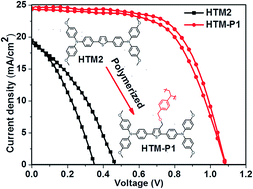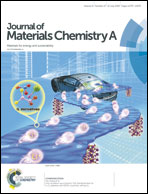Polystyrene with a methoxytriphenylamine-conjugated-thiophene moiety side-chain as a dopant-free hole-transporting material for perovskite solar cells†
Abstract
A novel side-chain polymer was designed and synthesized by integrating a methoxytriphenylamine-conjugated-thiophene moiety as the hole transporting material (HTM) unit on a polystyrene side-chain (HTM–P1) by the radical polymerization of its relevant monomer (HTM–M1). These two materials and their similar model compound without the styrene moieties (HTM2) were used as the HTMs for perovskite solar cells (PSCs). The results showed that with similar device preparation and measurement conditions, the hole mobility of polymer HTM–P1 was about 3 times and 2.5 times that of HTM2 and HTM–M1, respectively. PSCs based on HTM–P1 as the dopant-free HTM afford an impressive highest power conversion efficiency of 17.2%, which is much higher than those obtained from HTM2 (3.2% without the dopant and 14.7% with the dopant) and HTM–M1 (9.7%). Moreover, the devices based on the HTM–P1 presented significantly higher stability than the device based on its model compound of HTM2. Hence, this study demonstrates that the side-chain polymer strategy is an effective approach to achieve high efficiency and highly stable PSCs using dopant-free HTMs.



 Please wait while we load your content...
Please wait while we load your content...